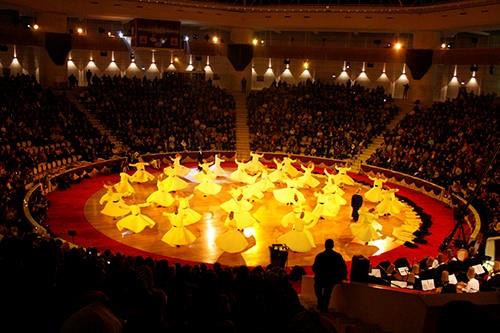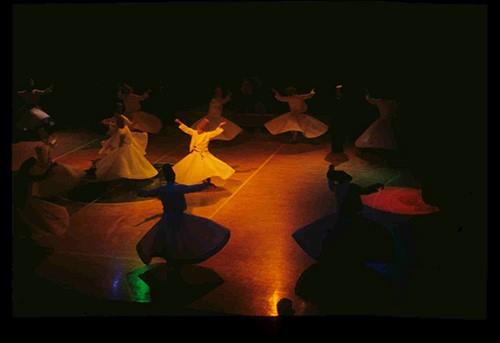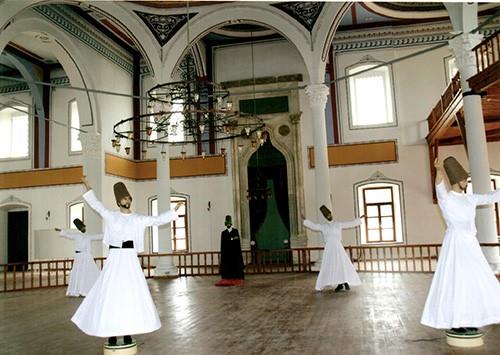Mevlevi Sema Ceremony
- Esra Ekingen
- September 22, 2021
- 9:11 pm
The Mevlevi Sema Ceremony is a Sufi ceremony that symbolizes stages on the path to accessing God and contains religious elements and themes with detailed rules and characteristics. While this ceremony unique to the Mevlevi sect had no specific rules in Mevlâna Celaleddin-i Rumî’s day (deceased December 17, 1273), it began to be performed in a disciplined way from the time of Sultan Veled and Ulu Arif Çelebi. These rules were developed until the time of Pir Adil Çelebi, when they assumed the final form we have today.
The ceremony consists of the noble eulogy to the Prophet Mohammed, flute solo, prelude, the Circling of Veled and four segments (selam), which form an integral whole and contain different Sufi meanings. The Sema Ceremony is performed with traditional Mevlevi music in spaces where Mevlevi culture can be properly transmitted. The ceremony begins with the Noble Eulogy (naat-ı şerif), which is the score composed by Itri and has been played since the late 17th century. Hymns written by composers such as Pir Adil Çelebi are sung by a trained chorus, which is accompanied by instruments such as the ney (flute), kettledrum and oud. The works of Rumi written in Persian are the basic source of the compositions performed by the musicians and singers during the ceremony.
The ceremony begins with the recitation of the Noble Eulogy (naat-ı şerif), which praises the Prophet Mohammed. This is followed by the ney solo. When the ney solo ends, the whirling dervishes go to the places indicated by the head dervish and begin the sema. The Circling of Veled, which begins after this, depicts the resurrection from the dead. The whirling dervish’s cloak resembles the grave, his hat the gravestone, and he is considered dead when sitting. In the service that begins after the Circling of Veled, the whirling dervishes slowly remove their cloaks, thus freeing themselves from worldly affairs.




While the whirling dervishes are spinning in the Mevlevi Sema as a symbol of the heavenly realm, the chief dervish moves among them, making sure they maintain proper distance between them. The person who directs the ceremony is called the Post-nişîn, and he stands at the end of a red fleece reciting prayers. It is assumed that the sema represents the solar system because the place where it is performed is round, and the Post-nişîn is compared to the sun, the chief dervish to the moon and the dervishes to the planets.The selam portion of the sema ceremony consists of four segments: The first selam describes how humans accept their status as created beings, the second selam the rapture felt when confronted with God’s omnipotent power, the third selam the transformation of rapture at God’s power into love, and the fourth selam how humans return to serve. The ceremony ends with the reading of the Qur’an and prayers.
This ceremony requires skill and concentration to perform and includes mystical symbols at several stages from the beginning to the end. Whirling during the sema represents witnessing God in all places and aspects. The stamping of the feet symbolizes crushing the boundless insatiable desires of the ego underfoot, striving against and defeating the ego. Holding one’s arms out to the side is the need for ultimate perfection. During the sema, the arms are open with the right hand held up and the left hand down, which symbolizes blessing from God received with the right hand while turning away from everyone else and distributing these blessings with the left hand.


The whirling dervishes who perform the ceremony must undergo rigorous spiritual and physical training before they are ready for the service. All of the postures and demeanors in the area where the sema are performed conform to rule of decency. Individuals who perform the sema are expected to be capable of reading and understanding the written works of Rumi and to have the skill required to engage in arts such as music and calligraphy. The course of training required for the whirling dervish will put him on a spiritual journey, in other words it will put him on the path of the Perfect Man, which envisions transformation and development after the acquisition of knowledge. The spiritual journey includes many different stages, such as loyalty, love, service, the remembrance of God and solitude.
The Mevlevi Sema Ceremonies that describe divine love in artistic terms with choreography and complex musical structure are performed at least twice a week throughout the summer, particularly in Istanbul and Konya. The Konya Turkish Sufi Music and Istanbul Historical Turkish Music Groups established under the auspices of the Ministry of Culture and Tourism also perform at events that include Mevlevi services. Huge audiences from home and abroad attend the Mevlevi Sema Ceremonies held on the Night of Reunion (December 17), which is the anniversary of Rumi’s death and is recognized as the night on which the servant met his Lord.


Mevlevi culture emerged in the 13th century, was developed and changed over time and became an important part of Turkish history and culture. The way to preserve and keep it alive, especially the Sema ceremony, is to teach it to future generations without marring the technical and internal perfection and originality of the tradition. In order to ensure that the Mevlevi Sema Ceremonies are performed without compromising their essence, a protective action plan has been drawn up that includes not only the Ministry of Culture and Tourism but many civil society organizations as well.
As part of the UNESCO Anniversary Celebrations List, UNESCO proclaimed 2007 to be the “800th Anniversary of the Birth of Mawlana Jalal-ud-Din Balkhi-Rumi.”. A number of events related to Mevlana and Mevlevi culture were organized both in Turkey and abroad, and the Mevlevi Sema Ceremony was performed.


To ensure that the Mevlevi Sema Ceremony is performed without compromising its essential character, the Ministry of Culture and Tourism issued in 2008 the Circular Regarding Mevlevi Culture-Sema Ceremonies. According to this Circular, the Sema Ceremony must be performed with traditional works from Mevlevi Music, which are an inseparable part of the Sema, in spaces where this culture can be accurately transmitted and introduced and in environments that meet the necessary requirements. The dervishes and musicians who participate in the programs must possess the necessary technical and musical competence. They must conduct themselves solemnly, aware that they are not only representing a culture during the program but performing “a transcendent practice with Sufi characteristics.”
Among the many artistic events held as part of the Istanbul 2010 European Capital of Culture program, the Mevlevi Sema Ceremonies attracted significant interest. The Galata and Yenikapı Mevlevi lodges have been restored in keeping with the mystical atmosphere and essence of the ceremonies, and converted into cultural centers where whirling dervishes are trained.


The costume worn by the dervishes during the sema ceremonies is extremely important. Making the felt hats called sikke worn by the Mevlevi dervishes is not only difficult, but it is also a laborintensive process of creation. Today, Mehmet GİRGİÇ is one of the rare craftsmen who make these sikke hats. The sikke hats currently in the Mevlana Museum were made by him. Girgiç was proclaimed a “Living Human Treasure” by the Ministry of Culture and Tourism in 2010 for his works.
The Mevlevi Sema Ceremony, which was proclaimed a Masterpiece in 2005 within the framework of the UNESCO Masterpieces of the Oral and Intangible Cultural Heritage of Humanity Program, was registered on UNESCO’s Representative List of the Intangible Cultural Heritage of Humanity in 2008 on behalf of our country and thereby introduced to the world.
